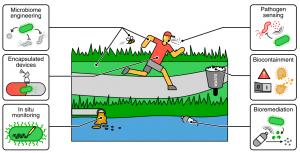Enhancing Precision and Adaptability in Genetic Sensor Technology
Researchers explore enhanced sensing capabilities in synthetic biology to address global challenges and regulatory constraints
USA, July 1, 2024 /EINPresswire.com/ -- In genetic sensor research, precision and sensitivity remain challenges. Against this backdrop, researchers now leveraged synthetic biology1, high-throughput assays, and bioinformatics to enhance sensor capabilities. They have highlighted the advanced detection accuracy of protein-based sensors, RNA aptamers, and novel synthetic metabolic pathways such as SEMP for disease biomarkers and environmental pollutants. These findings promise improved diagnostic tools and environmental monitoring, indicating a future of more effective biotechnological applications.
Genetic sensors play a crucial role within organisms by regulating gene expression in response to environmental stimuli. Despite their significance, their development is impeded by challenges such as slow growth rates in source organisms and limitations in precision and sensitivity. Previous studies have aimed to harness these natural sensing capabilities to address pressing global challenges such as food security, sustainable manufacturing, diagnostics, and healthcare. These efforts underscore the importance of advancing genetic sensor technology to enhance their efficiency and applicability across various fields.
In a recent study led by Dr. Thomas Gorochowski, researchers have pushed the boundaries of genetic sensor technology. This review, published online in in Volume 6 of BioDesign Research journal on June 25, 2024, has identified more efficient and versatile biosensors capable of detecting a broad spectrum of substances with high specificity and sensitivity. Reflecting on their work, Dr. Gorochowski emphasized, “As synthetic biology solutions move towards real-world applications, embedding advanced sensing and control mechanisms will be essential for ensuring their safe and reliable deployment.”
Their research methodology focused on exploring diverse genetic sensor architectures, each designed to improve sensitivity and specificity for various applications. Central to their study are protein-based sensors, which directly bind to target molecules, influencing gene expression. These sensors operate through single-component systems, where a lone protein detects the target, and two-component systems involving a sensor histidine kinase and a response regulator. This dual approach ensures strong detection capabilities customized for specific environmental or biomedical targets.
RNA aptamers represent another pivotal aspect of their study, situated in the 5’-UTR of transcripts. These aptamers form intricate structures that hinder translation upon binding with specific target molecules. Renowned for their versatility in detecting a broad spectrum of targets with high specificity, RNA aptamers are indispensable tools in genetic sensor technology, offering precise control over gene expression dynamics.
Their research also included innovative synthetic approaches that significantly advanced sensor capabilities. Techniques like Sensing Enabled by Metabolic Pathways (SEMP) were deployed to engineer synthetic metabolic pathways capable of converting target molecules into detectable forms. Concurrently, Toehold switches (THS), utilizing synthetic RNA structures, regulated translation in response to specific RNA targets. Moreover, the adaptation of CRISPR-Cas systems for RNA sensing provided unprecedented control over gene expression, highlighting the versatility and adaptability of their synthetic strategies.
Beyond the diversity of sensor types explored, the integration of genetic sensors with light and electric signals represents a significant leap forward in technology. This innovation allows for precise control over gene expression dynamics, leveraging electronic and optical devices to expand the capabilities of genetic sensors in diagnostics and environmental monitoring. By merging biological systems with these technologies, the research team has broadened the scope of genetic sensor applications, promising transformative impacts across scientific disciplines.
The findings from this research carry significant implications, particularly in reshaping healthcare diagnostics, environmental monitoring, and biotechnological applications. With the development of more efficient genetic sensors, there comes an enhancement in their precision and flexibility, suggesting a future where these sensors will assume critical roles in personalized medicine, sustainable resource management, and industrial biotechnology. This progress promises to revolutionize how we detect diseases, monitor environmental health, and optimize industrial processes, making the way for advancements that cater to diverse global challenges.
In conclusion, this review underscores the transformative potential of genetic sensor technology. By unraveling the complexities of sensor development and deployment, the study lays a robust foundation for future innovations in synthetic biology and biomedical engineering. Dr. Gorochowski highlighted the significance of their work, stating, "Control processes in synthetic biology are already emerging, and further integrating control engineering principles into genetic sensor design is crucial for their widespread deployment in everyday applications." This forward-looking approach not only advances scientific understanding but also sets the stage for practical applications that address complex challenges in healthcare, sustainability, and industrial processes.
DOI
10.34133/bdr.0037
Original Source URL
https://doi.org/10.34133/bdr.0037
Journal
Biodesign research
Lucy Wang
BioDesign Research
email us here
1 https://doi.org/10.34133/bdr.0037

